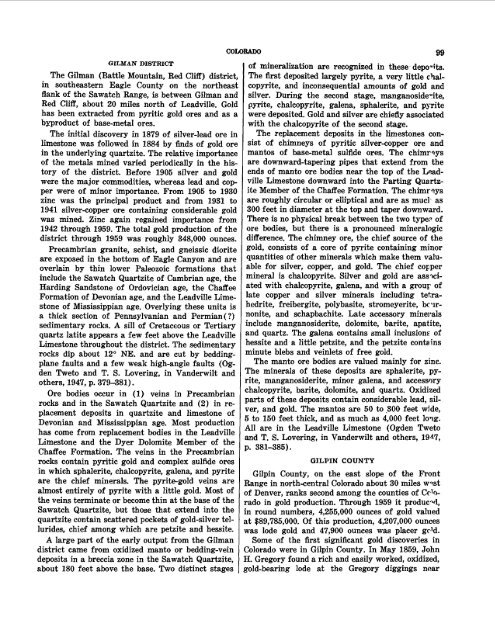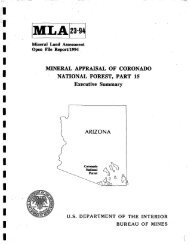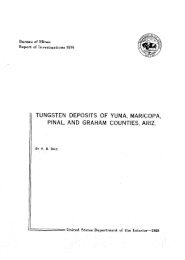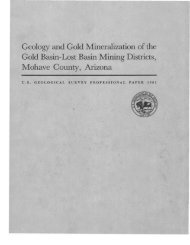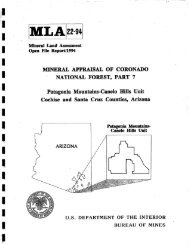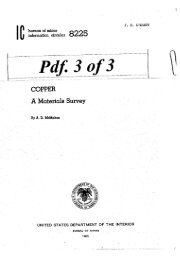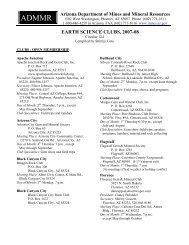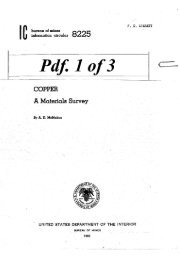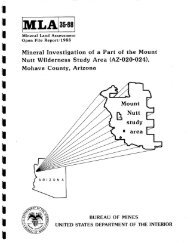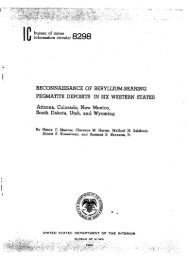here - State of Arizona Department of Mines and Mineral Resources
here - State of Arizona Department of Mines and Mineral Resources
here - State of Arizona Department of Mines and Mineral Resources
Create successful ePaper yourself
Turn your PDF publications into a flip-book with our unique Google optimized e-Paper software.
GILMAN DISTRICT<br />
The Gilman (Battle Mountain, Red Cliff) district,<br />
in southeastern Eagle County on the northeast<br />
flank <strong>of</strong> the Sawatch Range, is between Gilman <strong>and</strong><br />
Red Cliff, about 20 miles north <strong>of</strong> Leadville. Gold<br />
has been extracted from pyritic gold ores <strong>and</strong> as a<br />
byproduct <strong>of</strong> base-metal ores.<br />
The initial discovery in 1879 <strong>of</strong> silver-lead ore in<br />
limestone was followed in 1884 by finds <strong>of</strong> gold ore<br />
in the underlying quartzite. The relative importance<br />
<strong>of</strong> the metals mined varied periodically in the history<br />
<strong>of</strong> the district. Before 1905 silver <strong>and</strong> gold<br />
were the major commodities, w<strong>here</strong>as lead <strong>and</strong> copper<br />
were <strong>of</strong> minor importance. From 1905 to 1930<br />
zinc was the principal product <strong>and</strong> from 1931 to<br />
1941 silver-copper ore containing considerable gold<br />
was mined. Zinc again regained importance from<br />
1942 through 1959. The total gold production <strong>of</strong> the<br />
district through 1959 was roughly 348,000 ounces.<br />
Precambrian granite, schist, <strong>and</strong> gneissic diorite<br />
are exposed in the bottom <strong>of</strong> Eagle Canyon <strong>and</strong> are<br />
overlain by thin lower Paleozoic formations that<br />
include the Sawatch Quartzite <strong>of</strong> Cambrian age, the<br />
Harding S<strong>and</strong>stone <strong>of</strong> Ordovician age, the Chaffee<br />
Formation <strong>of</strong> Devonian age, <strong>and</strong> the Leadville Limestone<br />
<strong>of</strong> Mississippian age. Overlying these units is<br />
a thick section <strong>of</strong> Pennsylvanian <strong>and</strong> Permian( ?)<br />
sedimentary rocks. A sill <strong>of</strong> Cretaceous or Tertiary<br />
quartz latite appears a few feet above the Leadville<br />
Limestone throughout the district. The sedimentary<br />
rocks dip about 12° NE. <strong>and</strong> are cut by beddingplane<br />
faults <strong>and</strong> a few weak high-angle faults (Ogden<br />
Tweto <strong>and</strong> T. S. Lovering, in V<strong>and</strong>erwilt <strong>and</strong><br />
others, 1947, p. 379-381).<br />
Ore bodies occur in (1) veins in Precambrian<br />
rocks <strong>and</strong> in the Sawatch Quartzite <strong>and</strong> (2) in replacement<br />
deposits in quartzite <strong>and</strong> limestone <strong>of</strong><br />
Devonian <strong>and</strong> Mississippian age. Most production<br />
has come from replacement bodies in the Leadville<br />
Limestone <strong>and</strong> the Dyer Dolomite Member <strong>of</strong> the<br />
Chaffee Formation. The veins in the Precambrian<br />
rocks contain pyritic gold <strong>and</strong> complex sulfide ores<br />
in which sphalerite, chalcopyrite, galena, <strong>and</strong> pyrite<br />
are the chief minerals. The pyrite-gold veins are<br />
almost entirely <strong>of</strong> pyrite with a little gold. Most <strong>of</strong><br />
the veins terminate or become thin at the base <strong>of</strong> the<br />
Sawatch Quartzite, but those that extend into the<br />
quartzite contain scattered pockets <strong>of</strong> gold-silver tellurides,<br />
chief among which are petzite <strong>and</strong> hessite.<br />
A large part <strong>of</strong> the early output from the Gilman<br />
district came from oxidized manto or bedding-vein<br />
deposits in a breccia zone in the Sawatch Quartzite,<br />
about 180 feet above the base. Two distinct stages<br />
COLORADO 99<br />
<strong>of</strong> mineralization are recognized in these-depo..its.<br />
The first deposited largely pyrite, a very little chalcopyrite,<br />
<strong>and</strong> inconsequential amounts <strong>of</strong> gold <strong>and</strong><br />
silver. During the second stage, manganoside,,-,ite,<br />
f>yrite, chalcopyrite, galena, sphalerite, <strong>and</strong> pyrite<br />
were deposited. Gold <strong>and</strong> silver are chiefly associated<br />
with the chalcopyrite <strong>of</strong> the second stage.<br />
The replacement deposits in the limestones consist<br />
<strong>of</strong> chimneys <strong>of</strong> pyritic silver-copper ore <strong>and</strong><br />
mantos <strong>of</strong> base-metal sulfide ores. The chimr"!ys<br />
are downward-tapering pipes that extend from the<br />
ends <strong>of</strong> manto ore bodies near the top <strong>of</strong> the LP..adville<br />
Limestone downward into the Parting Quartzite<br />
Member <strong>of</strong> the Chaffee Formation. The chimr"!ys<br />
are roughly circular or elliptical <strong>and</strong> are as mucl' as<br />
300 feet in diameter at the top <strong>and</strong> taper downward.<br />
T<strong>here</strong> is no physical break between the two type:> <strong>of</strong><br />
ore bodies, but t<strong>here</strong> is a pronounced mineralogic<br />
difference. The chimney ore, the chief source <strong>of</strong> the<br />
gold, consists <strong>of</strong> a core <strong>of</strong> pyrite containing minor<br />
quantities <strong>of</strong> other minerals which make them valuable<br />
for silver, copper, <strong>and</strong> gold. The chief COIJper<br />
mineral is chalcopyrite. Silver <strong>and</strong> gold are ass')ciated<br />
with chalcopyrite, galena, <strong>and</strong> with a grour <strong>of</strong><br />
late copper <strong>and</strong> silver minerals including tetrahedrite,<br />
freibergite, polybasite, stromeyerite, bC"lrnonite,<br />
<strong>and</strong> schapbachite. Late accessory mine)'als<br />
include manganosiderite, dolomite, barite, apatite,<br />
<strong>and</strong> quartz. The galena contains small inclusiom <strong>of</strong><br />
hessite <strong>and</strong> a little petzite, <strong>and</strong> the petzite contains<br />
minute blebs <strong>and</strong> veinlets <strong>of</strong> free gold.<br />
The manto ore bodies are valued mainly for zinc.<br />
The minerals <strong>of</strong> these deposits are sphalerite, pyrite,<br />
manganosiderite, minor galena, <strong>and</strong> accessl)ry<br />
chalcopyrite, barite, dolomite, <strong>and</strong> quartz. Oxidized<br />
parts <strong>of</strong> these deposits contain considerable lead, silver,<br />
<strong>and</strong> gold. The mantos are 50 to .300 feet wide,<br />
5 to 150 feet thick, <strong>and</strong> as much as 4,000 feet IO'1g.<br />
All are in the Leadville Limestone (Ogden Tweto<br />
<strong>and</strong> T. S. Lovering, in V<strong>and</strong>erwilt <strong>and</strong> others, 19


